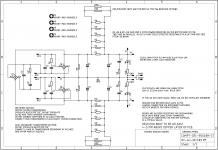I have not so much experience in this topology with such low value and Panasonic caps < 470 (in fact I have but more with digital in these values) ! If it can support the 1500 to 1800 I spoke above : you may like it, the size here doesn't compromise the subjective fastness or so.
You should try also a FC and FR in the range you need // with a PPS smd 1210/16 size case of 1 uF/100v ... and of course first without the 1 uF.
Just my two cents, but I setup all my devices with ears not being a special of the scop ! I surmise also the scop not being a specialist (often) of tonal balance...
You should try also a FC and FR in the range you need // with a PPS smd 1210/16 size case of 1 uF/100v ... and of course first without the 1 uF.
Just my two cents, but I setup all my devices with ears not being a special of the scop ! I surmise also the scop not being a specialist (often) of tonal balance...
Last edited:
With regards to capacitor specifications,
I always read use "low ESR", "high ripple current" but no one ever quantifies that.
What is "low ESR" and what is not "low ESR", same with "ripple current".
Let's assume (cause this is what I am doing), a PS with a 300VA dual 36v toroidal feeding a 100 watt mono AB amp using four 10,000uf caps at 63v.
This is the PSU circuit diagram,

What would be considered good ESR and ripple current?
What would be bad ESR and ripple current?
Thank you,
David.
I always read use "low ESR", "high ripple current" but no one ever quantifies that.
What is "low ESR" and what is not "low ESR", same with "ripple current".
Let's assume (cause this is what I am doing), a PS with a 300VA dual 36v toroidal feeding a 100 watt mono AB amp using four 10,000uf caps at 63v.
This is the PSU circuit diagram,

What would be considered good ESR and ripple current?
What would be bad ESR and ripple current?
Thank you,
David.
Octopart lists about 100 different 10,000uf 63v capacitors,
100 different 10000uf 63v capacitors
with an ESR between 12mΩ and 80mΩ and a ripple current between 3.72 amps and 17 amps, priced between $2.20 and $30.35 each.
100 different 10000uf 63v capacitors
with an ESR between 12mΩ and 80mΩ and a ripple current between 3.72 amps and 17 amps, priced between $2.20 and $30.35 each.
has anyone tried the Kemmet "T" network lytics?
https://www.mouser.com/datasheet/2/212/KEM_A4030_ALN20S-1775071.pdf
https://www.mouser.com/datasheet/2/212/KEM_A4030_ALN20S-1775071.pdf
Strange to read that ppl think the power caps have no effect on the sound. It's a very old fact that faster caps sound better. It's normal physics. High end amps derive their grip and power on the lows from it. Which ones are the best only depends on the internal resistance and therefore the speed with which they can discharge.
Not actually a fact, so prove your assertion using physics if you can!It's a very old fact that faster caps sound better. It's normal physics. High end amps derive their grip and power on the lows from it.
The high speed decoupling should always be on the amp pcb(s) where its actually needed for stability anyway, there is no requirement for "speed" per se from bulk PSU caps, but you do want the ESR to be low enough for the load current involved (and this applies equally to the decoupling on the amp board which will typically handle the higher frequency current anyway).
Here's some good reading material from someone who really knows their stuff: Capacitor Characteristics
I usually replace the caps with the same type or better. Prefer long life caps and purchased from Farnell/E14/RS Components. Reason, better chance of getting fresher caps with the manufacturer's DOM.
If the 12 x 10mF caps are lugged with wiring and screws, I would file the lugs flatly & raw on both sides for maximum contact. Lugs I have cleaned are solid copper, heavy with a grey coat over over it. I hate crimped lugs in heavy current situations, prefer to solder the wire & lug for the best electrical bond
If the 12 x 10mF caps are lugged with wiring and screws, I would file the lugs flatly & raw on both sides for maximum contact. Lugs I have cleaned are solid copper, heavy with a grey coat over over it. I hate crimped lugs in heavy current situations, prefer to solder the wire & lug for the best electrical bond
Ok, hereby: The slew rate and / or grip on the speaker of an amp is based on total circuit resistance during discharging of the capacitors. The lower circuit resistance, the more electrical grip on the voicecoil of the speaker. Actually all high end amps share the high speed/internal resistance as the same ground rule for the final quality of the amp. I worked as engineer at JK Acoustics (high end audio equipment manufacturer in NL) and we were actually talking more about the capacitors than the brand of amps itself as a measure for the soundstage and depth of an amp. And yes, the trick of a photo (flash) capacitor to pep up the amp was also tested a lot and gave brilliant results. Only that trick has a price: photo flash caps are not designed for daily use hour after hour. So life span is quite limited. And when they fail they have a nasty death.. so I do not advice that unless you are a true hobbiest and replace them every half year or soNot actually a fact, so prove your assertion using physics if you can!
And no I don't fell that I need to read your book, but thanks for the tip anyway

- Home
- Design & Build
- Parts
- Who make the best 10,000uf capacitors